The Oort cloud is a theoretical cloud of predominantly icy solid objects that are believed to surround the Solar System at distances ranging from 2.000 to 200.000 AU.
Key Facts & Summary
- The Oort cloud is yet to be directly observed, but many pieces of evidence point to its existence in the far reaches of the Solar System, thus surrounding us.
- It is named after the Dutch astronomer Jan Oort, who in 1950 proposed the idea that certain comets come from a vast and extremely distant spherical shell of icy bodies engulfing the Solar System.
- Oort believed that this cloud is the origin of most of the long-period comets that have been observed, like the famous Halley’s Comet for example.
- For centuries comets have been cataloged and observed by astronomers. Yet new comets come around that suggest a different point of origin. They come from all directions and it is speculated that they have a short lifespan since they melt, collide, or are influenced by gravity from other objects thus pointing to the existence of a reservoir of comets, the Oort cloud.
- The examination of the orbits of these comets helped astronomers to construct their entire orbits, further evidencing the existence of the cloud.
- The comets orbits are elliptical and their aphelion point is usually at a relatively common distance of 20.000 AU, further suggesting the existence of the reservoir of comets.
- The Oort cloud is speculated to contain billions or even trillions of objects.
- The inner edge of the Oort cloud is thought to be about 2.000 to 5.000 AU from the Sun.
- The outer edge is believed to be about 10.000 to 100.000 AU from the Sun. This is equivalent to one quarter to half the distance between the Sun, and the nearest neighboring star, Proxima Centauri.
- Some comets that probably came from the Oort cloud, orbit the Sun once every 200 years or more.
In 1932, Estonian astronomer Ernst Öpik suggested that long-period comets originated in an orbiting cloud at the outermost edge of the Solar System.
However, it was the Dutch astronomer Jan Oort who independently revived the idea in 1950 as a means to resolve this paradox and as such, the theory now bears his name.
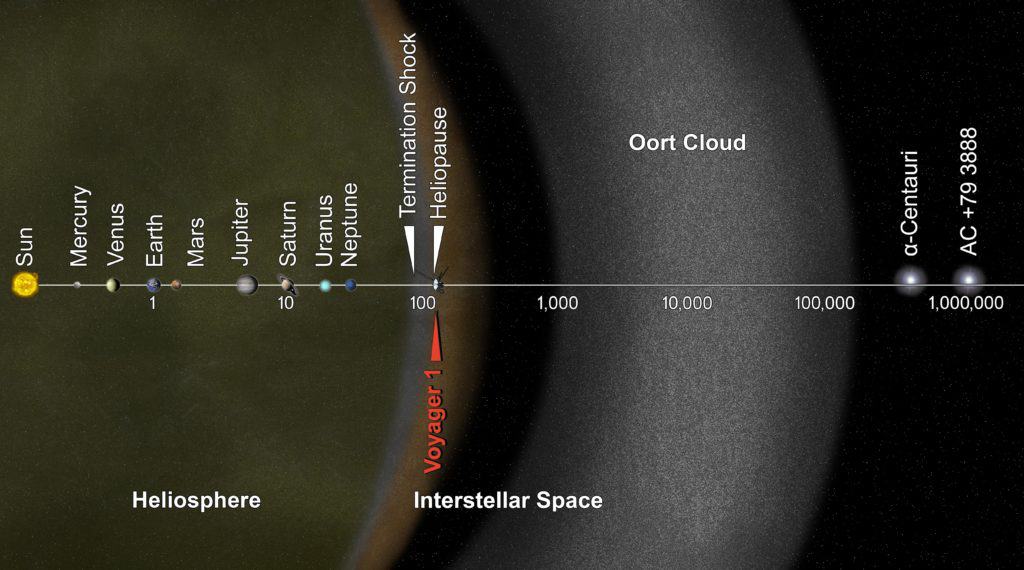
Hypothesis for the Oort cloud
Comets can be classified into two distinct classes:
- Short-period comets: called ecliptic comets
- Long-period comets: called nearly isotropic comets
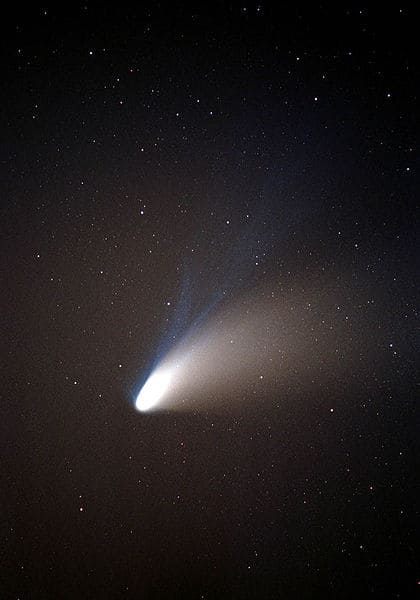
The ecliptic comets have relatively small orbits, below 10 AU, and follow the ecliptic plane, which is the same plane where planets lie.
The long-period comets, on the other hand, have very large orbits, reaching up to thousands of AU, and appear from every direction in the sky.
Oort reasoned that a comet could not have formed while in its current orbit, and must have been held in an outer reservoir for almost all of its existence.
He argued that there was a peak in numbers of long-period comets with their aphelia relatively common, roughly 20.000 AU. This suggested that a reservoir at that distance exists, with a spherical, isotropic distribution.
Formation
There are many ideas on how the Oort cloud must have formed. However, the leading idea suggests that the icy objects were not always so far from the Sun.
When the planets formed around 4.6 billion years ago, the region in which they formed still contained lots of leftover chunks called planetesimals.
Some of them were ejected from the solar system entirely, while others were flung into eccentric orbits where they were still held by the Sun’s gravity, but were far enough out that galactic influences also tugged on them.
These planetesimals formed from the same material as the planets did. Gravity from some planets such as Jupiter, scattered the planetesimals every which way. Probably the strongest influence was the tidal force of our galaxy.
In the end, gravity from the planets shoved many icy planetesimals away from the Sun, and gravity from the galaxy itself, likely caused them to settle in the borderlands of the solar system, where planets couldn’t perturb them anymore.
This is the leading idea, however, the Oort cloud could also capture objects that didn’t form in the solar system.
Composition
The Oort cloud is composed out of billions, maybe even trillions of icy bodies/debris, that range from dust particles, to some being as big as mountains. Billions of them have absolute magnitudes.
The total mass is unknown, but the Halley’s Comet is a suitable prototype for comets within the outer Oort cloud, roughly the combined mass is about five times that of Earth. The mass of the inner Oort cloud hasn’t been yet estimated.
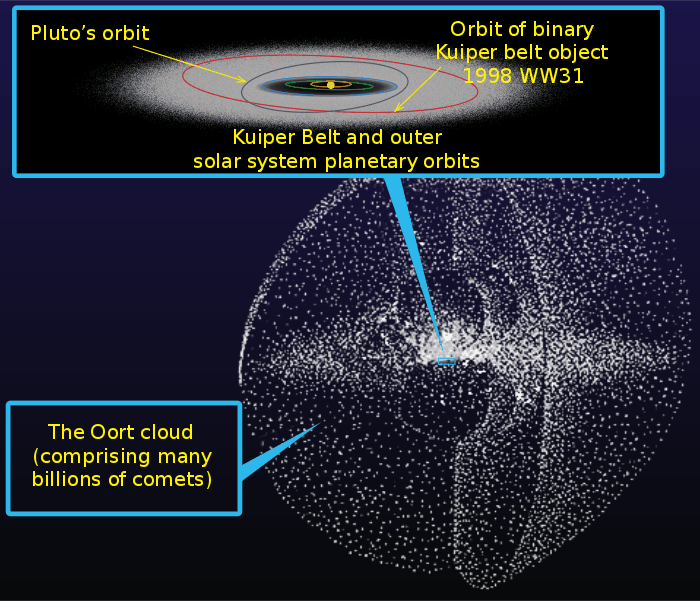
If the comets that have been analyzed are representative of the whole, the vast majority of Oort-cloud objects consist of ices such as water, methane, ethane, carbon monoxide, and hydrogen cyanide.
However, theoretical researches suggest that the Oort cloud population may consist of roughly 1 – 2 % asteroids, thus different compositions.
Scale and Distance
One AU is the equivalent of about 93 million mi / 150 million km. The space occupied by the Oort cloud is vast, between 2.000 and 5.000 AU, to as far as 50.000 AU from the Sun.
There are estimates that place the outer edge of the Oort cloud at around 100.000 and 200.000 AU. The region can be subdivided into a spherical outer Oort cloud of 20.000-50.000 AU, and a torus-shaped inner Oort cloud of 2.000-20.000 AU.
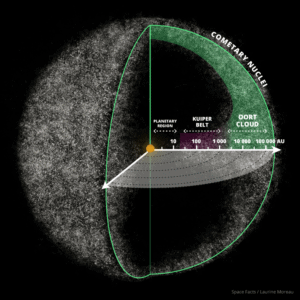
The outer cloud is only weakly bound to the Sun and supplies the long-period and possibly Halley-type comets to inside the orbit of Neptune.
The inner Oort cloud – also termed as Hills cloud – is predicted to have tens or hundreds of times as many cometary nuclei as the outer halo. It is seen as a possible source of new comets.
Orbit and Rotation
Objects in the Oort cloud do not necessarily travel in the same direction, in a shared orbital plane around the Sun.
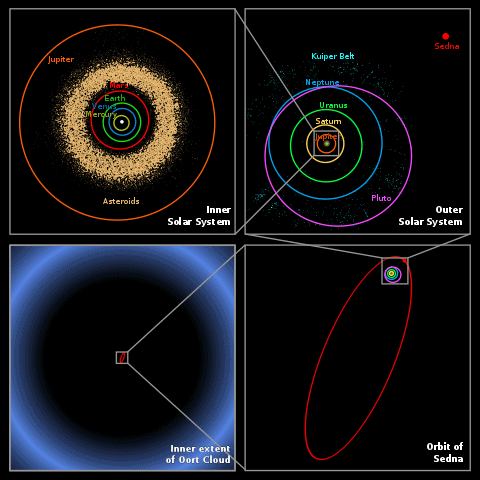
They can also travel under/over and at various inclinations around the Sun, as a thick bubble of distant, icy debris. This is why it is called the Oort cloud rather than the Oort belt.
Future exploration
The spacecraft Voyager 1 is headed towards the Oort cloud, however, it is estimated that it will not be functional anymore by 2025. The Oort cloud is too far away and too dim to be observed, however, it may be possible to find an object from the cloud that has been knocked into the inner Solar System.
With the advancement of technology, it may become possible to finally observe the Oort cloud and prove its existence, and since its existence is in question, the mystery will forever bind us to further explore and solve this paradox.
Did you know?
- The Oort cloud is speculated to start from roughly 300 billion km out, almost 70 times farther out than Neptune or around 2.000 times the distance from the Earth from the Sun.
- The Oort cloud is believed to extend up to 1 light year, or around 10 trillion km.
- The Voyager 1 spacecraft which travels at a speed roughly of 1 million mi per day, will eventually reach the inner boundary of the Oort cloud in about 300 years, and will probably exit the far side in about 30.000 years.
- Recent studies have shown that the formation of the Oort cloud is broadly compatible with the hypothesis that the Solar System formed as part of an embedded cluster of 200–400 stars.
- Some theories suggest that the Sun may have captured Oort Cloud cometary material from the outer disks of other stars that were forming in the same nebula as our star.
- The planetoid Sedna, which was discovered in 2003, is believed to be a member of the Oort cloud.
Source:
Image source:
- https://upload.wikimedia.org/wikipedia/commons/d/da/PIA17046_-_Voyager_1_Goes_Interstellar.jpg
- https://upload.wikimedia.org/wikipedia/commons/thumb/2/2f/Comet_Hale-Bopp.jpg/420px-Comet_Hale-Bopp.jpg
- https://upload.wikimedia.org/wikipedia/commons/thumb/5/56/Kuiper_belt_-_Oort_cloud-en.svg/700px-Kuiper_belt_-_Oort_cloud-en.svg.png
- https://space-facts.com/wp-content/uploads/oort-cloud.png[5.] https://upload.wikimedia.org/wikipedia/commons/thumb/d/d9/Oort_cloud_Sedna_orbit.svg/480px-Oort_cloud_Sedna_orbit.svg.png
